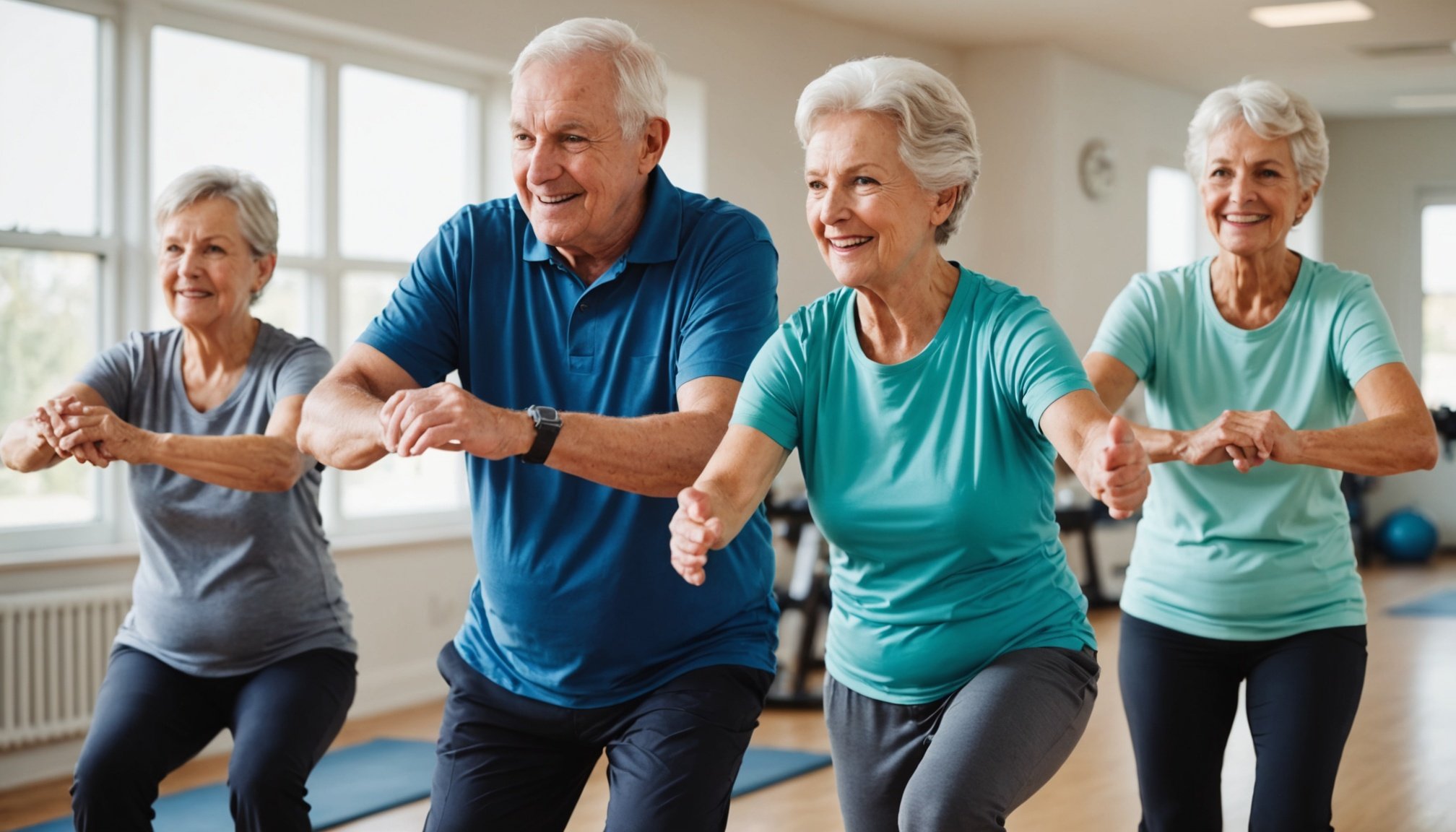As we age, maintaining mobility becomes increasingly important for seniors. Mobility not only affects our physical capabilities but also our overall quality of life. Engaging in the right types of exercise can significantly enhance our ability to move freely and safely. In this article, we will explore some of the best low-impact exercises that seniors can incorporate into their daily routines to promote strength, flexibility, and balance.
Understanding Low-Impact Exercises
Low-impact exercises are activities that place minimal stress on the joints while still providing an effective workout. Unlike high-impact exercises, which can be jarring and potentially harmful, low-impact movements allow seniors to improve their fitness levels without the risk of injury. These exercises are particularly beneficial as they promote cardiovascular health, strength building, and improved flexibility.
Also to see : How can family dynamics influence the well-being of senior citizens?
Incorporating low-impact exercise into your routine can also help in maintaining a healthy weight, enhancing mental health, and boosting overall energy levels. For seniors, this means engaging in exercises that elevate heart rates without straining the body.
Moreover, low-impact workouts are often adaptable. Seniors can modify their routines based on their fitness levels and any existing health conditions. A well-rounded exercise program can include strength training, stretching, and aerobic activities, all of which can be performed in a controlled manner that prioritizes safety and comfort.
Have you seen this : What are the best ways for seniors to stay informed about health issues?
Benefits of Low-Impact Exercises for Seniors
Engaging in low-impact exercises offers a plethora of benefits for seniors. First and foremost, these exercises are excellent for enhancing mobility. Improved mobility allows seniors to perform daily tasks more easily, such as walking, bending, and climbing stairs. This newfound freedom can instill a sense of independence and confidence.
Low-impact exercises also contribute significantly to building and maintaining muscle strength. As we age, muscle mass naturally declines, which can lead to frailty and increased risk of falls. By incorporating strength training into your exercise routine, you can combat this decline, promoting better balance and stability.
Additionally, low-impact exercises can foster social connections. Many seniors participate in group classes, which not only provide physical benefits but also encourage interaction and camaraderie among peers. These social aspects can have a positive impact on mental health, reducing feelings of isolation and depression.
Finally, low-impact workouts lower the risk of injury and strain. Seniors often have to be cautious of their physical limitations, and the gentle nature of low-impact exercises makes them a safer choice. This aspect of safety is crucial in preventing accidents and ensuring that seniors can maintain their active lifestyles.
Top Low-Impact Exercises to Enhance Mobility
There are various low-impact exercises that seniors can choose from to enhance their mobility. Here are some of the most effective options:
-
Walking: Walking is perhaps the simplest and most accessible low-impact exercise. It can be done almost anywhere, and varying the pace or increasing the distance can provide a great workout. Aim for at least 30 minutes a day to reap the benefits.
-
Cycling: Using a stationary bike or cycling outdoors can be an excellent way to improve cardiovascular fitness and strengthen leg muscles without putting too much pressure on the joints.
-
Swimming: The buoyancy of water reduces the impact on joints, making swimming a fantastic option for seniors. It promotes cardiovascular health and builds strength without any stress on the body.
-
Yoga: This ancient practice focuses on stretching, flexibility, and balance. Many senior-friendly yoga classes cater specifically to older adults, emphasizing gentle movements and breathing techniques.
-
Tai Chi: Known for its slow, flowing movements, Tai Chi is an excellent option for improving balance and coordination. This practice can also enhance mental focus and relaxation.
-
Chair Exercises: These workouts allow seniors to exercise while seated, making them accessible for those with limited mobility. Simple movements can strengthen muscles and improve circulation.
By integrating these exercises into your weekly routine, you can enhance your mobility, strength, and overall well-being.
Creating a Safe Exercise Routine for Seniors
Safety should always be a top priority when creating an exercise routine for seniors. Here are some essential tips to ensure a safe and effective workout experience:
-
Consult a Healthcare Provider: Before starting any new exercise program, it’s crucial to consult with a healthcare provider. They can offer guidance based on your specific health needs and limitations.
-
Start Slowly: If you are new to exercise, begin with short sessions and gradually increase the duration and intensity. This approach helps your body adjust without overwhelming it.
-
Stay Hydrated: Hydration is essential, especially during physical activity. Ensure you drink enough water before, during, and after your workouts to prevent dehydration.
-
Use Proper Gear: Invest in a good pair of supportive shoes to provide stability and comfort during your exercises. Proper clothing can also enhance your workout experience.
-
Listen to Your Body: Be attentive to how your body feels during exercise. If you experience pain or discomfort, stop and assess the situation. It’s crucial to recognize your limits and modify exercises as needed.
-
Incorporate Rest Days: Rest is just as important as exercise. Allow your body time to recover by scheduling rest days into your routine.
By adhering to these safety tips, you can create an effective and enjoyable exercise routine that supports your mobility and overall health.
Making Exercise a Habit
Incorporating low-impact exercises into your daily life requires commitment and motivation. Here are some strategies to help you make exercise a regular part of your routine:
-
Set Realistic Goals: Establish achievable fitness goals that are tailored to your current abilities. Celebrate your progress, no matter how small, to maintain motivation.
-
Schedule Workouts: Treat your exercise sessions like important appointments. Block out time in your calendar specifically for physical activity, and stick to it.
-
Find a Workout Buddy: Exercising with a friend can make workouts more enjoyable and provide accountability. You’re less likely to skip a session when someone else is counting on you.
-
Mix It Up: Variety is key to keeping your exercise routine fresh and engaging. Try different activities, such as swimming, walking, or yoga, to avoid boredom.
-
Track Your Progress: Keep a journal or use a fitness app to record your workouts. Tracking your progress can help you stay motivated and see the results of your efforts.
-
Embrace the Outdoors: Whenever possible, take your workouts outside. Fresh air and natural surroundings can enhance your mood and make exercising feel less like a chore.
By implementing these strategies, you can effectively make low-impact exercise a regular part of your lifestyle, ultimately enhancing your mobility and overall well-being.
Low-impact exercises provide numerous benefits for seniors looking to enhance their mobility and overall quality of life. By understanding the nature of these exercises and implementing a safe routine, you can significantly improve your physical abilities while reducing the risk of injury. Remember that consistency is vital; by making exercise a habit, you can maintain your independence and enjoy an active lifestyle well into your later years. Now is the time to embrace these low-impact activities and prioritize your mobility for a healthier, happier life.











